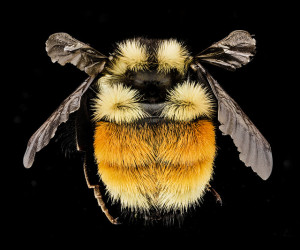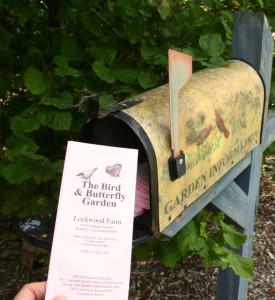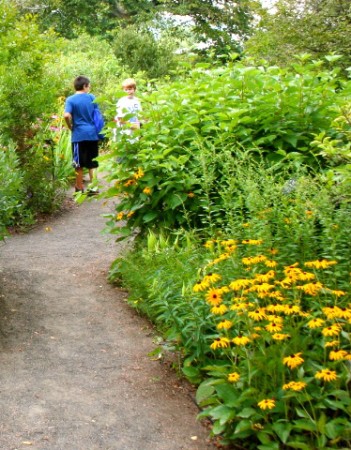Pollinators – Myriads Hard At Work Daily – Honored By Connecticut, USA
In the dance of life, pollinators make the music happen. Bees. Butterflies and moths. Birds and bats. Beetles and other insects. Animals. Pollinators are in trouble as they face habitat loss, disease, parasites, and environmental contaminants that contribute to the decline of many species. Why should you care? Food. Crops. Reproduction happens because a pollinator (or the wind in some cases) visits each flower – which is, yes indeed, a reproductive structure. Once successfully fertilized, a flower makes a seed, a nut, a fruit, a berry. Each one engineered to carry DNA forward to make a new generation. (There is a reason adolescents get an all-important talk about the “birds and the bees.”)

Tracy Zarrillo making observations of bees on lavender. Photo by Ellen Bulger at Jones Family Farm in Shelton, Connecticut.
A wealth of pollinators are at work in our backyard, across the country, the globe.
To highlight this important work, Governor Dannel Malloy has proclaimed the week of June 15 to June 21, as Pollinator Week in Connecticut in recognition of the “importance of pollinators, the assistance provided to beekeepers by The Connecticut Agricultural Experiment Station (CAES), and the research by CAES and the University of Connecticut on honey bees and wild bees.”
State Entomologist Dr. Kirby Stafford said that “the proclamation from Governor Malloy recognizing the importance of our pollinators is very timely with the recent release by the White House of a National Pollinator Strategy for the management and protection of our honey bees, native bees, and other pollinators, as well as for the Monarch butterfly.”

Here is one pollinator at work on one flower. A female squash bee (Peponapis) on a male pumpkin blossom. Photo by Jess Gambel, CAES.
“In addition to the managed honey bee, there are at least 326 documented species of wild bees in Connecticut,” noted Dr. Kimberly Stoner, CAES Associate Agricultural Scientist Department of Entomology. “Many crops, such as pumpkin and squash, are primarily dependent on these native bees for pollination.”
Dr. Stoner studies the pollination of pumpkin and winter squash on farms across the state. She also monitors native bee diversity in selected agricultural and natural habitats. (Her recommendation to view the diversity of bees are the visually stunning images featured on the Flickr site of the U.S. Bee Monitoring Lab, a Federal government laboratory run by Sam Droege of the U.S. Geological Survey.)

Bombus ternaries, the orange-belted bumble bee. Image is linked to the USGS Bee Inventory and Monitoring Lab and more of Sam Droege's work.
CAES scientists participate in national, regional, and state projects measuring the exposure of honey bees to pesticides in pollen and the movement of pesticides into the pollen and nectar of flowering plants treated with systemic insecticides. These research projects are funded by the U.S. Department of Agriculture, the Connecticut Department of Energy and Environmental Protection, and the Horticulture Research Institute.
Pollinators play a vital role for Connecticut’s gardens and agriculture, and also for the reproduction of our vast diversity of native flowering plants. Honey bee pollination, provided by more than 1,000 beekeepers with more than 6,000 honey bee hives registered with the Office of the State Entomologist, has an estimated value of at least $13.8 million to the orchards in the state.

Ben Gluck and Christy Bell sweeping marjoram for bees at Lockwood Farm, the CAES research farm in Hamden. Photo by Dr. Stoner, CAES.
In addition, the state’s beekeepers also produced 155,991 pounds of honey from 227 operations valued at $609,000 according to the USDA National Agriculture Statistic Service’s 2012 Census of Agriculture.
In May 2015, Assistant to the President for Science & Technology and Director of the White House Office of Science and Technology Policy Dr. John P. Holdren, announced new steps to promote pollinator health, including a science-based Pollinator Research Action Plan.
It is well worth reading. Here are excerpts along with references:
From the Introduction:
“Pollinators are crucial members of various ecosystems, from farmland to wilderness. There are an estimated 352,000 flowering plant species, many of which depend on pollinators to reproduce (National Research Council 2007; “The Plant List” 2013). …
“The attributed value of crops in the United States that are directly dependent on insect pollination was estimated at $15.12 billion in 2009, including an estimated $11.68 billion of crop value directly attributable to honey bees (Calderone 2012). Estimates for both insect pollination, generally, and honey bee pollination, specifically, for crop values are dependent on the amount of acres cultivated and crop prices (Calderone 2012).
“The value of pollinators in natural systems is much more difficult to discern, given that the maintenance of natural plant communities through pollination contributes to a variety of valuable ecosystem services, including carbon sequestration, water filtration, and erosion control (National Research Council 2007).”
In Section 10: From Research to Application: Models, Tools and Best Practices: “Translating basic research into decision tools and vetting those tools in real-world situations is a critical component of improving pollinator health. People of all ages and communities across the country can play a role in responding to the President’s call to action. You can share some land with pollinators – bees, butterflies, other insects, birds, bats – by planting a pollinator garden or setting aside some natural habitat. You can think carefully before applying any pesticides and always follow the label instructions. You can find out more about the pollinator species that live near you.”
Pollinators are partners for life here on Earth.There is a universe of interconnectedness in all life that remains to be studied and brought to light. If environmental factors are disrupting smaller life forms, humans should take heed as to the reasons why.
Media serve as pollinators of a different sort as they carry ideas from one sector to another. Libraries are gardens and repositories of minds no longer present; their accumulated knowledge stands ready to serve others.

A handy garden information leaflet from the mailbox at Lockwood Farm. See for yourself on Plant Science Day, Aug. 5.
Editor's note: For more information, CAES fact sheets on ground nesting bees, bee species found on flowering plants on vegetable farms, protecting pollinators from pesticides, and planting flowers for bees in Connecticut, are available at this link.
Another helpful resource is Discover Life, an online visual encyclopedic meeting point for all forms of life. Its mission is to “assemble and share knowledge about nature in order to improve education, health, agriculture, economic development, and conservation throughout the world” – and everyone concerned is encouraged to contribute. The Polistes Foundation is a 501 (c) 3 non-profit organization established in 2002 to support Discover Life. “This page is a portal to all living things — the world's flora and fauna. Click on the photographs to examine the taxonomy, natural history, distribution, abundance, and ecology of each group.”

On a grass-roots, do-something level, the newly formed National Pollinator Garden Network has created a challenge to the public to help cultivate a million pollinator gardens in the U.S., creating “a network of bee-safe habitat that reaches all corners of the country.”
Last, but not least; a bee has helped launch at least one business. BeeSweet Lemonade has an inspiring backstory about a young girl with open-minded intelligent parents who helped her ask questions after she was stung by a bee. That led to first an appreciation for, then a love of bees and a desire to help them. She is also growing her own profitable enterprise that features honey as an ingredient.




